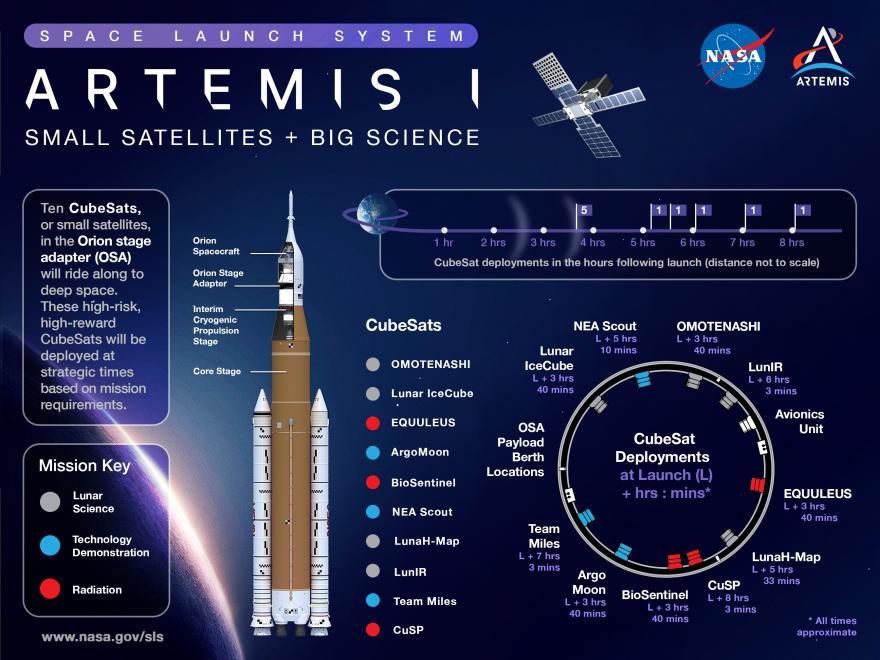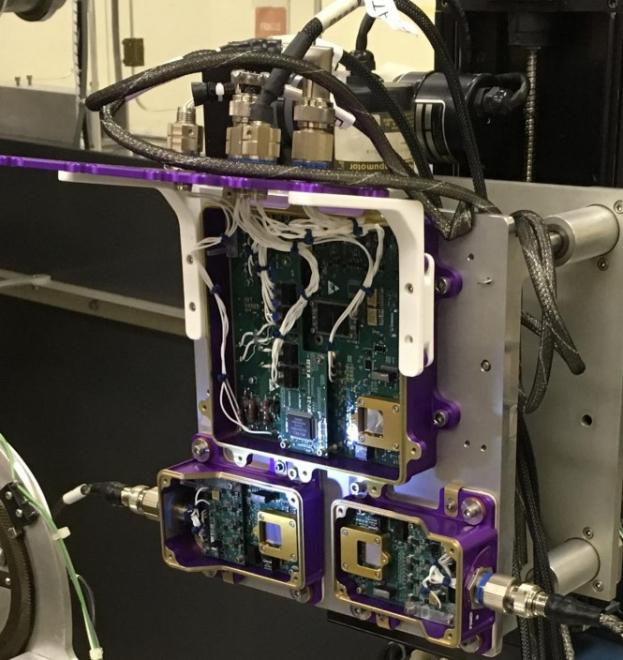Artemis 1 will be the first ever integrated test mission of NASA’s deep space exploration systems which would include the Orion spacecraft and the Space Launch System (SLS) rocket. It will lay the foundation for human deep space exploration by studying the flight of the spacecraft through deep space for longer periods of time and gathering data on radiation, surface of moon, communication systems in deep space etc. It will be a stress test for a spacecraft built for astronauts wherein it will travel 280,000 miles from earth on the world’s most powerful propulsion systems, stay in space longer than any spacecraft has ever stayed in space without docking to the ISS and will re-enter the earth faster than ever.
Launch specifications
The SLS carrying the Orion will be propelled off from Launch Pad 39B at NASA’s modernized spaceport at Kennedy by a pair of five-segment boosters (which will separate from SLS after two minutes) and four RS-25 engines(which will deplete the fuel eight minutes after launch). After this the core stage will shut down and separate from the spacecraft, leaving Orion attached to the interim cryogenic propulsion stage (ICPS) that will help it leave the earth’s orbit for the moon. The ICPS will then detach alongwith deployment of cubesats, and Orion will be propelled by the service module provided by the ESA. After reaching 62 miles above the surface of the moon, Orion will be put into the stable deep retrograde orbit beyond the moon where the spacecraft will be tested in the deep space environment for 40,000 miles with lesser fuel consumption. After spending 6 to 19 days, it will perform a departure burn to the moon from where it will perform a return powered flyby burn (at 60 miles above the moon surface) to slingshot itself to a trajectory to return to earth.
The trajectory of the mission can be understood via the image shown below:

Scientific payload aboard
The SLS will be carrying a number of cubesats such as OMOTENASHI, Lunar IceCube, LunaH-Map, LunIR, CuS, ArgoMoon, BioSentinel, EQUULEUS etc. A description of these can be found as follows:

-
Lunar IceCube will use a spectrometer to investigate lunar ice and its dynamics i.e. the absorption and release of water from the regolith (the Moon’s rocky and dusty surface). The cubesat will also study the exosphere of the moon to predict the seasonal changes and how they affect the lunar ice.
-
LunaH-Map will measure the distribution and amount of hydrogen throughout the Moon’s South Pole with the intention of producing a high resolution map of moon’s bulk water deposits to get details on the spatial and depth distribution of potential ice to understand how water got in there and how much is available for exploitation for future missions.
-
OMOTENASHI will test the technologies and trajectory maneuvers that allow a small lander to land on the Moon while keeping its systems including power, communication, and propulsion systems intact. This will aid in development of similar small landers. This cubesat will also study radiation in the low earth orbit which will help in developing technologies for managing human exposure to radiation.
-
LunIR will conduct a lunar flyby and use advanced miniature infrared sensors(which will be able to map the moon at both day and night and function at higher temperatures) to collect data on lunar surface and its material, composition, thermal signatures, presence of water, and potential landing sites.
-
CuSP will study the particles and magnetic fields that stream from the Sun by orbiting the sun with three instruments to measure incoming radiation and the magnetic field that can create a variety of effects on Earth, such as interfering with radio communications, tripping up satellite electronics, and creating electronic currents in power grids.
-
NEA Scout will chase down a near Earth asteroid 2020GE (smallest asteroid to be ever studied). It will use its camera (with a resolution of less than 4 inches per pixel) to determine whether 2020GE is one large solid boulder or a composition of many small rocks and dust particles. It will also determine its size, shape, rotation, surface properties and surrounding debris. This will help in gaining useful insight on planetary defense from asteroids. The cubesat will demonstrate solar sail technology i.e. it will generate thrust by reflecting solar-photons from its 925 square feet aluminum sail. This system will be assisted by small cold gas thrusters.
-
EQUULEUS will move to earth-moon lagrange point 2 to demonstrate trajectory control techniques and image earth’s plasmasphere for understanding how to protect humans and electronics from radiation damage during space journey.
-
BioSentinel will measure the impact of space radiation on living organisms over long durations beyond low-Earth orbit by entering an orbit around the sun via lunar flyby. It will use dry yeast cells stored in microfluidic cards as a “living radiation detector” to evaluate the effects of ambient space radiation on biological mechanisms such as DNA damage and repair.
-
ArgoMoon will perform autonomous vision-based proximity operations around the ICPS by using high-definition cameras and advanced imaging software to record images of the ICPS, earth, moon and provide deployment data on other CubeSats, and test optical communication capabilities between the CubeSat and Earth.
-
Team Miles will demonstrate propulsion using plasma thrusters in deep space with the intention of traveling 59.6 miles before ending its mission. It will be run autonomously by sophisticated onboard computers.
Radiation Research
It is important to understand the possible radiation exposure in space and how to shield the human body during space travel. The Orion will experience the intense radiation of the Van Allen Belts as it will pass through the Earth’s magnetosphere and thereafter it will experience the deep space radiation environment caused by solar energetic particle events produced by the Sun and particles from galactic cosmic rays.


-
Radiation Area Monitor (RAM): It will include six radiation area monitors(RAM) to record the total radiation dose during the mission. They will require no power source and info will be analyzed after Orion lands on earth.
-
Hybrid Electronic Radiation Assessor (HERA): It will be an active instrument (requiring power) that will measure the charged particles passing through its sensors and simultaneously send the data back on earth. It will sound a warning in case of solar energetic particle event.
On-board Manikin
The manikin will be equipped with two radiation sensors and will wear a first-generation Orion Crew Survival System spacesuit. Its seat will be outfitted with two sensors (one under the headrest and another behind the seat) to record acceleration and vibration throughout the mission. Five additional accelerometers inside Orion will provide data for comparing vibration and acceleration between the upper and lower seats during the impact of splashdown. The manikin crew is expected to experience a force of 2.5g during ascent and 4g during descent. The data collected from artemis 1 will be used to verify crew safety on Orion by measuring the flight data against predicted values and making necessary adjustments.